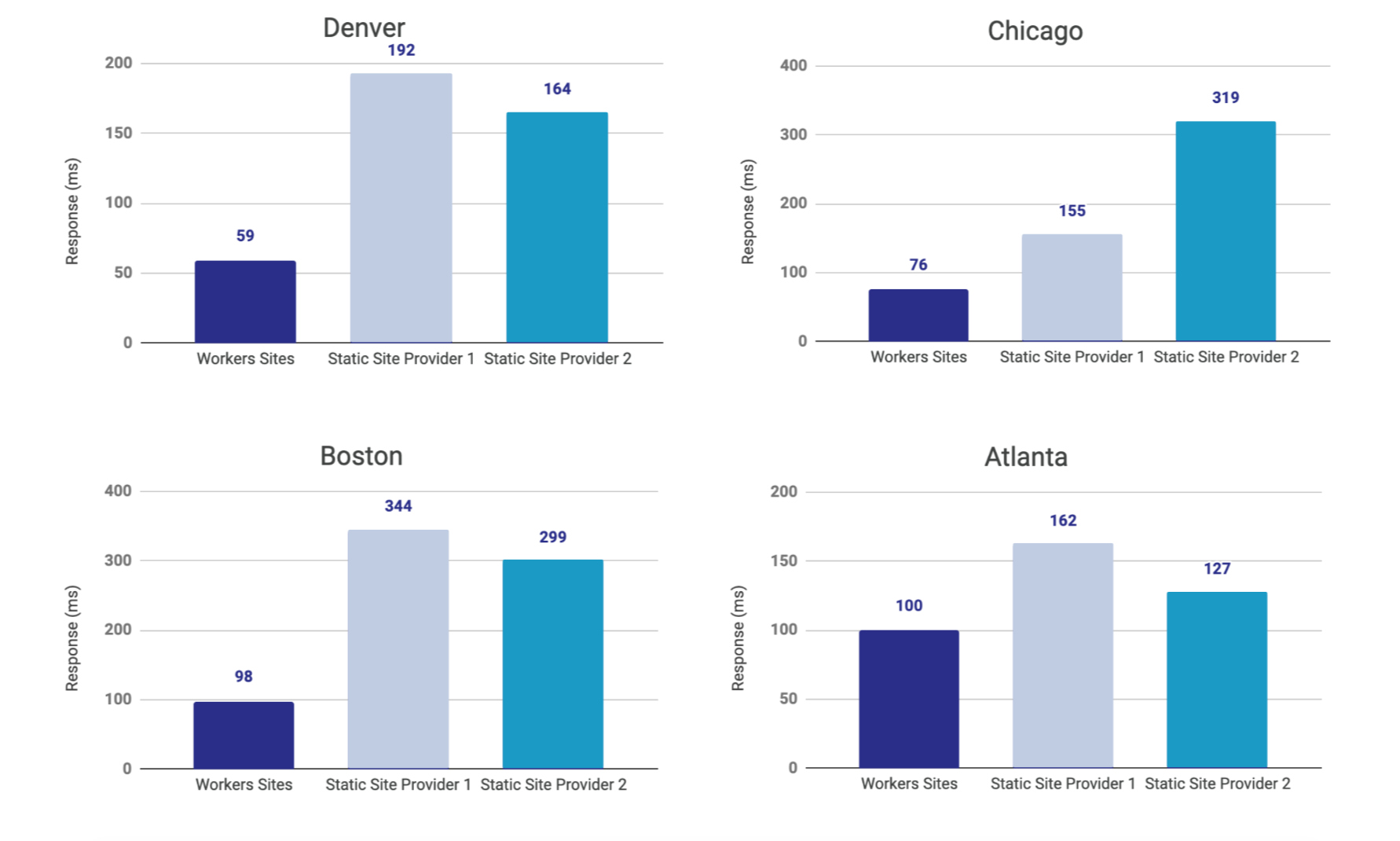Update: since publishing this blog post, we've released Cloudflare Pages. If you're using Cloudflare for hosting sites, Cloudflare Pages is better suited for this use case.
Performance on the web has always been a battle against the speed of light — accessing a site from London that is served from Seattle, WA means every single asset request has to travel over seven thousand miles. The first breakthrough in the web performance battle was HTTP/1.1 connection keep-alive and browsers opening multiple connections. The next breakthrough was the CDN, bringing your static assets closer to your end users by caching them in data centers closer to them. Today, with Workers Sites, we’re excited to announce the next big breakthrough — entire sites distributed directly onto the edge of the Internet.
Deploying to the edge of the network
Why isn’t just caching assets sufficient? Yes, caching improves performance, but significant performance improvement comes with a series of headaches. The CDN can make a guess at which assets it should cache, but that is just a guess. Configuring your site for maximum performance has always been an error-prone process, requiring a wide collection of esoteric rules and headers. Even when perfectly configured, almost nothing is cached forever, precious requests still often need to travel all the way to your origin (wherever it may be). Cache invalidation is, after all, one of the hardest problems in computer science.
This begs the question: rather than moving bytes from the origin to the edge bit by bit clumsily, why not push the whole origin to the edge?
Workers Sites: Extending the Workers platform
Two years ago for Birthday Week, we announced Cloudflare Workers, a way for developers to write and run JavaScript and WebAssembly on our network in 194 cities around the world. A year later, we released Workers KV, our distributed key-value store that gave developers the ability to store state at the edge in those same cities.
Workers Sites leverages the power of Workers and Workers KV by allowing developers to upload their sites directly to the edge, and closer to the end users. Born on the edge, Workers Sites is what we think modern development on the web should look like, natively secure, fast, and massively scalable. Less of your time is spent on configuration, and more of your time is spent on your code, and content itself.
How it works
Workers Sites are deployed with a few terminal commands, and can serve a site generated by any static site generator, such as Hugo, Gatsby or Jekyll. Using Wrangler (our CLI), you can upload your site’s assets directly into KV. When a request hits your Workers Site, the Cloudflare Worker generated by Wrangler, will read and serve the asset from KV, with the appropriate headers (no need to worry about Content-Type, and Cache-Control; we’ve got you covered).
Workers Sites can be used to deploy any static site such as a blog, marketing sites, or portfolio. If you ever decide your site needs to become a little less static, your Worker is just code, edit and extend it until you have a dynamic site running all around the world.
Getting started
To get started with Workers Sites, you first need to sign up for Workers. After selecting your workers.dev subdomain, choose the Workers Unlimited plan (starting at $5 / month) to get access to Workers KV and the ability to deploy Workers Sites.
After signing up for Workers Unlimited you’ll need to install the CLI for Workers, Wrangler. Wrangler can be installed either from NPM or Cargo:
# NPM Installation
npm i @cloudflare/wrangler -g
# Cargo Installation
cargo install wranglerOnce you install Wrangler, you are ready to deploy your static site, with the following steps:
Run
wrangler init --sitein the directory that contains your static site's built assetsFill in the newly created
wrangler.tomlfile with your account and project detailsPublish your site with
wrangler publish
You can also check out our Workers Sites reference documentation or follow the full tutorial for create-react-app in the docs.
If you’d prefer to get started by watching a video, we’ve got you covered! This video will walk you through creating and deploying your first Workers Site:
Blazing fast: from Atlanta to Zagreb
In addition to improving the developer experience, we did a lot of work behind the scenes making sure that both deploys and the sites themselves are blazing fast — we’re excited to share the how with you in our technical blog post.
To test the performance of Workers Sites we took one of our personal sites and deployed it to run some benchmarks. This test was for our site but your results may vary.
One common way to benchmark the performance of your site using Google Lighthouse, which you can do directly from the Audits tab of your Chrome browser.

So we passed the first test with flying colors — 100! However, running a benchmark from your own computer introduces a bias: your users are not necessarily where you are. In fact, your users are increasingly not where you are.
Where you’re benchmarking from is really important: running tests from different locations will yield different results. Benchmarking from Seattle and hitting a server on the West coast says very little about your global performance.
We decided to use a tool called Catchpoint to run benchmarks from cities around the world. To see how we compare, we deployed the site to three different static site deployment platforms including Workers Sites.
Since providers offer data center regions on the coasts of the United States, or Central Europe, it’s common to see good performance in regions such as North America, and we’ve got you covered here:

But what about your users in the rest of the world? Performance is even more critical in those regions: the first users are not going to be connecting to your site on a MacBook Pro, on a blazing fast connection. Workers Sites allows you to reach those regions without any additional effort on your part — every time our map grows, your global presence grows with it.
We’ve done the work of running some benchmarks from different parts of the world for you, and we’re pleased to share the results:

One last thing...
Deploying your next site with Workers Sites is easy and leads to great performance, so we thought it was only right that we deploy with Workers Sites ourselves. With this announcement, we are also open sourcing the Cloudflare Workers docs! And, they are now served from a Cloudflare data center near you using Workers Sites.
We can’t wait to see what you deploy with Workers Sites!
Have you built something interesting with Workers or Workers Sites? Let us know @CloudflareDev!


